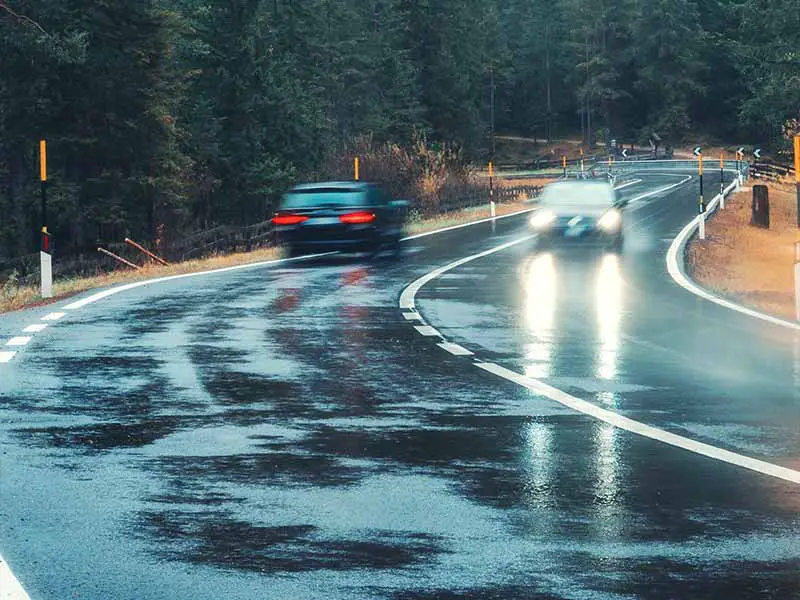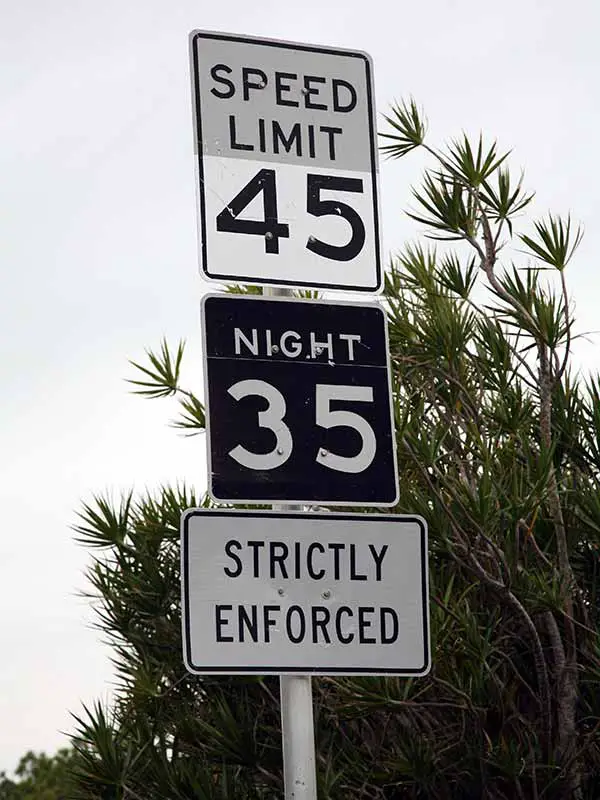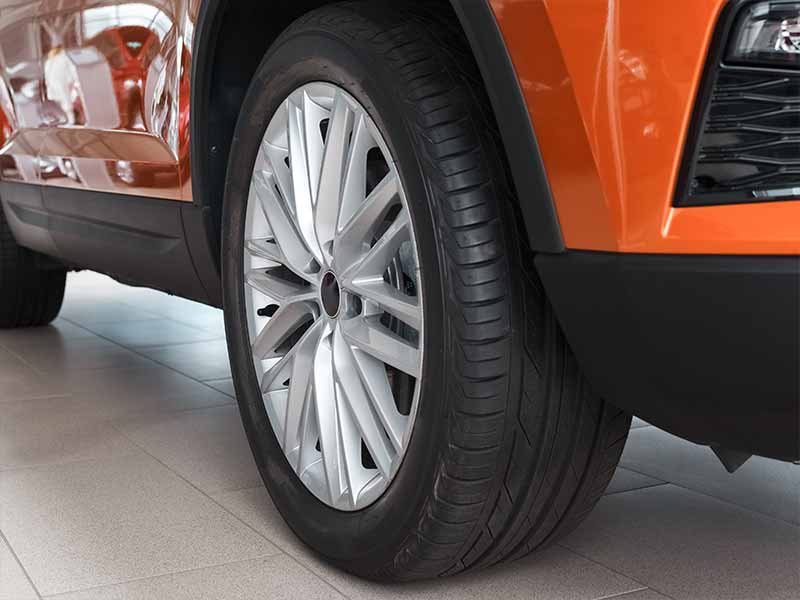New tires can much better resist hydroplaning than worn tires. But tread depth isn’t the only factor that affects wet traction. There are many other factors such as vehicle speed, vehicle weight, wider tires, water depth, etc.
Can You Hydroplane With New Tires?
Yes, even new tires can hydroplane.
It would take more water on the road surface or faster speeds, but new tires can still lose traction and hydroplane in wet conditions.
New tires resist hydroplaning much more easily than worn tires, but as speed increases, even new tires eventually can’t channel water out from underneath the contact patch of your tires fast enough.
No matter how new your tires are, to avoid losing control due to hydroplaning you should slow down. Speed is the single most important factor you control to reduce your risk.
Less tread depth plays a big role in your tire’s ability to resist hydroplaning. Unfortunately, while a deeper treads with wide circumferential grooves will greatly reduce your risk, you should be aware of all of the other contributing factors so you can better understand how to avoid hydroplaning maintain vehicle control if hydroplaning occurs.
Let’s take a closer look.
What Causes Hydroplaning?
When it comes to hydroplaning, there are three major causes. Let’s discuss each in more detail.
Water Depth
As you already know, you can’t hydroplane without water on the road. With that being said, the amount of water is a big factor that determines whether or not you’ll hydroplane.
In general, you can hydroplane with a very thin layer of water, if you’re going fast enough and your tread depth is low enough that it can’t channel water out from underneath your tire’s contact patch fast enough.
Still, your odds of hydroplaning go up as more water is present on the road. In other words, if the water is deeper, then you have a higher risk of losing control.
It’s also important to make a distinction between losing traction and hydroplaning. Skidding when you take a sharp turn on a wet road is not the same as hydroplaning.
Hydroplaning is the result of too much water for your tires to handle safely. Your tires will funnel out a certain amount of water, but as the water gets deeper, it gets overwhelming for your tires.

Speed
As you drive faster, more water is passing under your tires. In fact, speed is the one factor that you can control while you’re on the road. Our advice is to drive slower, because that lowers your chances of hydroplaning.
It’s possible to hydroplane as slow as 35 mph, but that’s mostly due to poor tread depth, Heavier rain or standing water, and lighter vehicles or wider tires.
If you feel the early signs of hydroplaning, it’s best to slow down to a lesser speed and continue driving. Hitting your brakes too hard to slow down can make things worse, and can cause you to spin out and lose control.
When the rain is coming down harder or you’re approaching an area with a lot of standing water, it’s wise to go even slower.

Tread Depth
There is a lot of science going on between your tires and the road as you’re driving. Notably, the tires tread depth plays a massive role when it comes to traction between your car and the road surface.
When rain is present on the road, traction can become iffy — this pertains to hydroplaning as well as poor overall grip.
As a result, the depth of your tread is extremely important on wet roads. Tread depth and tire tread patterns translate to how large of a groove there is to allow water to flow away from underneath your tires.
With little to no tread groove, rain can start to collect in front of your tires. Eventually, there is enough water building up in front of the tire that the tire can no longer keep up with the amount of water and it loses contact with the road surface and begins hydroplaning.
Generally, tires don’t have to be legally replaced until there’s around 2/32” of tread depth remaining. However, you’ll notice a remarkable performance dip at this level. It will take a lot longer to come to a complete stop when panic braking on wet roads with worn tires. This is even factoring in anti lock brakes which can maintain better grip than even the best driver.
It’s recommended that you replace your tires when the tread depth reaches 4/32″ instead of waiting until your tires are worn all the way down to a mere 2/32″. The difference in wet traction is most significant when your tires are very worn.
The difference in new tire stopping distances on wet pavement and those with only 4/32″ of tread remaining is typically 50% longer. The difference in stopping distance between 4/32″ and 2/32″ is typically another 50% longer. Most of your wet weather performance is lost in that last bit of tire wear.
Other Factors
Water, speed, and tire wear are the most significant concerns when it comes to hydroplaning, but they aren’t the only ones.
Vehicle Weight
Vehicle weight can increase or decrease the probability of hydroplaning occurring. Heavier vehicles require more speed or water to hydroplane. This isn’t much of a surprise if you think about it.
Tire Width
Tire width is also important. Wider tires help spread the weight of the car or truck out over a larger surface which makes it easier for the water to allow the vehicle to skim across the surface of the water.
Tire Maintenance
Tire maintenance can also affect wet traction. If your tires are rotated regularly, aligned, and properly inflated they will provide traction better than unevenly worn or those that are under or over inflated.
What Speed Does Hydroplaning Occur?
Unfortunately, there isn’t an exact speed that hydroplaning can happen. As we mentioned, hydroplaning can occur at speeds as low as 35 mph. Other times you can travel at highway speeds without any issues.
If your tires are fairly worn and there is more water depth on the road surface due to heavy rain or puddles, you should slow down more to prevent hydroplaning.
A good rule of thumb is to err on the side of caution when it’s raining or you encounter wet roads. It’s best to drive slower if it means avoiding hydroplaning. Again, vehicle speed is one of the few things you have control over to avoid hydroplaning.
How To Prevent Hydroplaning
Now that you know how hydroplaning happens, let’s explain the best practices to prevent hydroplaning:
Slow Down
First and foremost, you should slow down. Some drivers might feel pressure to drive at the speed limit, but the posted speed limits are assuming the roads are dry and clear. It’s okay to go under the speed limit if it means avoiding hydroplaning.
As a reminder, your vehicle’s speed is the leading cause of hydroplaning that you can control. It’s better to drive slower if it means avoiding a potential disaster. Even with low tire tread and exceptionally wet roads, driving slower can drastically reduce the risk of hydroplaning — assuming you’re driving slowly enough.
Avoid Standing Water
There are a number of reasons to avoid driving through standing water. Not the least of which is it will help lower the risk of hydroplaning. Puddles can quickly overwhelm your tires, especially if you’re driving at higher speeds.
You may not have any issues while driving in poor weather conditions to suddenly find that you hit a puddle and suddenly your tire’s ability to maintain road contact is lost due to a sudden increase in water depth.
Try to avoid puddles and ruts in the road where water collects if possible. Especially if your tires don’t have adequate tread depth.
Don’t Use Cruise Control
It might be tempting to put on cruise control at a slower vehicle speed so you don’t have to worry about dealing with the pedals while you’re driving. However, this can cause more trouble than it’s worth.
With cruise control on, you have no control over how the gas is applied. For adaptive cruise control, the same can be said about how the brakes are applied.
It’s best to turn off cruise control and monitor your car as you drive. If your car starts to vibrate or it feels like you’re losing grip, then you should ease off the accelerator pedal and commit to a slower speed.
Maintain Your Tires Properly
Brand-new tires are going to fare better on wet roads than old tires. For that reason, it’s best to keep up with your tire maintenance and check the condition of your tires before you start driving on wet roads.
If your tires have less than 4/32” of tread depth, you should use caution hitting the road, especially during a downpour.
Be sure to check the tire pressure, look for uneven wear, and measure the tread depth regularly.
What To Do When Hydroplaning
What if your car or truck begins hydroplaning? Here are a few tips you should keep in mind to help regain vehicle control.
Take Your Foot Off the Gas
If nothing else, you should be sure to take your foot off of the accelerator. Accelerating will only make things worse.
If you start hydroplaning, you might panic and push your foot even harder on the pedal. As a best practice, you should completely remove your foot from either pedal and leave your foot flat on the floor near your seat.
Firmly Grip the Steering Wheel
When you hydroplane, your car will sporadically find and lose traction. When this happens, your car might try to jerk in one direction and cause you to swerve.
The way to help combat this issue is to firmly grip your steering wheel the whole time. Regardless of what your car is trying to do, continue to point your steering wheel in the direction that your car is moving. It’s possible that your car can be sliding to the side while you’re facing forward. By following this rule, you should have your wheel turned to the side that you’re moving as well.
Doing this will maximize your chance of regaining control when your vehicle manages to find traction again.
Don’t Hit the Brakes
It might feel like second nature to slam on the brakes — after all, you can’t hydroplane if you’re stopped, right?
Your tires are not in contact with the road so the brake pedal will have little affect on slowing you down. It can however easily cause you to begin sliding sideways which will only make a bad situation worse.
As your tire hydroplanes, it will occasionally find grip momentarily. When it does so it will cause your car or truck to rotate and spin if your brakes are applied firmly. You may want to consider trying to brake gently to reduce the chance of a tire gripping briefly and skidding but still slowing you down slightly.
Resources
Below are some links you may find helpful when learning about tires
Final Thoughts
Be sure to remember that your vehicle’s speed is the easiest factor for you to control in the moment. If you find yourself driving in heavy rain or a lot of puddles and standing water, slow down.
Be aware of your tire’s tread wear and consider replacing them when they reach 4/32″ of remaining tread instead of 2/32″.
Finally, properly maintain your tires so they will be at their best when you need them the most. Check tire pressures often and have them rotated regularly.
Good luck and happy motoring.







